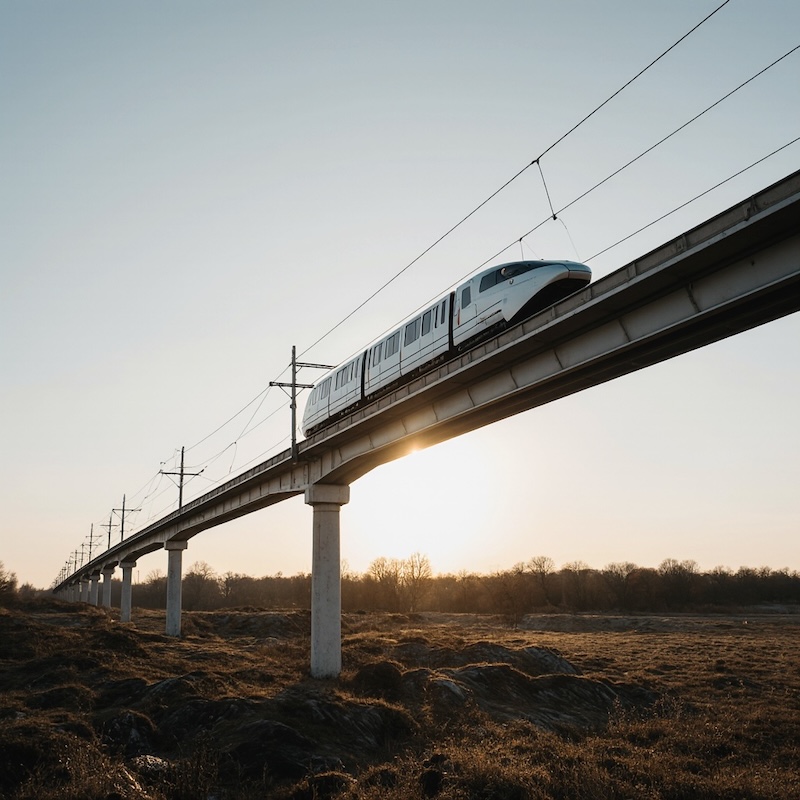
A recent research introduces a Nonlinear Model Predictive Control (NMPC) strategy for Maglev trains that reduces low-frequency vertical vibrations and improves ride comfort by integrating suspension dynamics into the control system without requiring additional hardware.
High-speed Maglev trains are a marvel of engineering—gliding at jaw-dropping speeds without touching the tracks. But while they’re fast, they haven’t always been smooth. Passengers still feel uncomfortable vertical vibrations caused by track irregularities. This recent study from the University of Stuttgart has a game-changing proposal: using Nonlinear Model Predictive Control (NMPC) to drastically improve ride comfort without adding any extra hardware! 🎉
In this article, we’ll break down this complex research into simple ideas and examples so everyone—whether an engineering student, professional, or curious traveler—can understand how this next-gen control system works.
Maglev trains like Germany’s famous Transrapid float above the track using electromagnetic suspension (EMS). Powerful magnets pull the train upwards while keeping it steady. But here’s the problem:
🚧 The guideway (the track) is not perfectly flat.
🔄 Slight imperfections cause the train to bounce up and down.
🤢 Passengers feel these vibrations, especially at low frequencies (under 5 Hz), leading to reduced comfort.
Older solutions either required expensive hardware (extra sensors and actuators) or accepted these vibrations as unavoidable.
Instead of adding more gadgets, this research proposes a software-based fix: improve the way the levitation system reacts using a smarter control strategy.
NMPC doesn’t just react to vibrations—it predicts them by modeling both the train’s mechanical suspension and electromagnetic forces in real time.
Use advanced AI-like control algorithms to balance two goals:
This is done by using existing sensors and magnets—no hardware upgrades necessary! 💰
The heart of NMPC is its ability to predict future vibrations based on a mathematical model of the train.
👨🔧 Previous systems used a single-mass model, focusing only on the levitation magnet. This controlled the air gap but did little to reduce what passengers feel inside the car.
🎉 The new method uses a two-mass model:
Between them is a spring-damper suspension that captures how vibrations travel from the track to the passengers. This lets the controller directly target ride comfort! 🛏️
Think of it like adding shock absorbers to your car but controlling them with AI that predicts every bump before it happens!
With the two-mass model in place, the researchers used Nonlinear Model Predictive Control (NMPC) to:
⚖️ Predict the train’s behavior over a set future time (called prediction horizon).
🎯 Optimize a cost function balancing:
At every moment (every millisecond!), the system solves a mathematical optimization problem and decides:
👉 What magnetic force should be applied now to keep things smooth?
To check if their smart control works, the researchers used two kinds of simulations:
| Controller | Comfort (Vibration) | Air Gap Stability | Speed |
|---|---|---|---|
| Old Method | ❌ Poor | ✅ OK | 🚄 600 km/h |
| New NMPC | ✅ Smooth Ride | ✅ Stable | 🚄 600 km/h |
Even with no extra sensors or magnets, NMPC cut uncomfortable movements without sacrificing safety!
This smarter controller:
✅ Improves passenger comfort without extra costs
✅ Stabilizes levitation, reducing risk of air gap loss
✅ Adapts to real-world imperfections in tracks
✅ Uses standard hardware—perfect for upgrades to existing Maglev systems
It’s a cost-effective upgrade that makes high-speed trains not only faster but also much more enjoyable to ride. 🥳
While the research is super promising, some improvements could make it even better:
⚙️ Real-world testing: Moving from simulation to test tracks.
⏱️ Optimization for embedded systems: Current setups require powerful computers—next step is making it run on standard train hardware.
🎁 Adaptive control: Adding more real-time learning, possibly using machine learning, so the train can self-adjust on different tracks.
🌍 Broader use: Could be adapted for other transport systems, like hyperloop pods or suspension bridges!
This research introduces a clever way to make Maglev trains more comfortable without extra hardware costs. By incorporating the vehicle’s suspension dynamics into a predictive control algorithm, the train gets a “smart brain” that keeps passengers happy at 600 km/h.
Next time you imagine future transportation, picture yourself gliding silently, smoothly, and safely—thanks to smart predictive algorithms. 🚀
🚄 Maglev (Magnetic Levitation) - A train that floats above the track using magnetic forces—no wheels, no friction, just smooth and super-fast rides!
🧲 Electromagnetic Suspension (EMS) - A system where electromagnets pull the train upwards, keeping a small air gap between the train and track so it hovers without touching the ground. - More about this concept in the article "🚄 Leveling Up Maglev Trains: How Data Makes Them Float Better!".
📏 Air Gap - The tiny space (usually a few millimeters) between the train’s magnets and the guideway—it needs to be stable for a safe and smooth ride!
🛑 Vibration - Up-and-down or shaking movements that can make rides uncomfortable, especially when caused by track imperfections.
🎛️ Controller (Control System) - A smart system that adjusts magnet forces in real time to keep the train stable and passengers comfortable.
🧮 Model Predictive Control (MPC) - A type of control system that predicts future train movements and adjusts actions ahead of time to avoid problems before they happen. - More about this concept in the article "Real-Time Flow Control with Lorentz Forces ⚡🧲".
🔄 Nonlinear Model Predictive Control (NMPC) - An advanced version of MPC that handles complex, real-world situations where things don't behave in simple straight lines (nonlinear behavior).
⚙️ Two-Mass Model - A simple simulation model of a train that includes both the magnets and the car body, making it easier to control both air gap stability and passenger comfort.
🎢 Ride Comfort - How smooth and relaxing a train ride feels—less shaking and bouncing = happier passengers! - More about this concept in the article "Revolutionizing Railway Comfort: A Game-Changing Suspension System for Smoother Rides 🚂".
Source: Mario Hermle, Arnim Kargl, Peter Eberhard. Vertical Vibration Reduction of Maglev Vehicles using Nonlinear MPC. https://doi.org/10.48550/arXiv.2507.13015
From: University of Stuttgart.